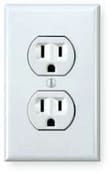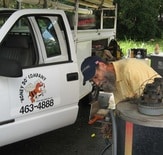by Ralph Corduan


Ralph Corduan is the Owner of the Honey Do Company, LLC. He holds an electrician's contractor license and has been a registered Handy-Man business since 2001 in the state of South Carolina.
Some of the following events are based on actual fiction. The names have been changed to protect the innocent …
I remember it well. It was not too late in the evening when Mr. Jones called. The summer had been typically warm and humid in 2014 and most folks were looking forward to a wonderful harvest and Christmas Season. The temperatures had already dropped into the 30’s at night and warmed up only into the mid 50’s during the day. “Hello, is this the Honey Do Company?” came the voice on the other end of the phone. My belly was full from dinner, as my wife and I were cleaning up the kitchen and nonchalantly I answered “Yes sir, how can I help you ..” Mr. Jones then proceeded to tell me about the events of the day – still not certain if he really did see Rudolph or not.
Earlier that morning Mrs. Jones got up and, before taking her morning shower, turned on the little space heater in the bathroom. Bob, her husband, stayed under the covers a little bit longer and then finally rolled out of bed himself. By this time Dot was already out of the shower toweling down and reaching for the hairdryer. Soon Bob heard the familiar high pitch screech of the hair dryer, when all of a sudden, it happened – Dot’s nose began to glow red …. No, no, no! That would be silly. The breaker popped and both the heater and the hair dryer stopped running. This was not the first time that this happened since the temperatures dropped and Bob went to the panel box to reset the breaker. All was well and everything came back on. He almost made it back into the bathroom when - -*POP* - - the breaker tripped again. A bit frustrated, he stopped in his tracks, turned around and threw the breaker again, but it did not stay. He waited a moment and tried again. Ahh, it took and he heard the hair dryer come back on.
Now this is when it really happened...
Bob looked down to the floor to see where he was going and … saw the red glow of Rudolf’s nose right behind the hall receptacle. All of his childhood memories of Santa and the North Pole were renewed in an instant. He was once again convinced! As quickly as he could manage - grabbing for a flashlight and a screwdriver - he wanted to remove the cover plate to see the entire legendary reindeer. But he stopped short when he saw the sheetrock. All his eyes could focus on was a long dark streak where coal must have scratched the sheetrock by the receptacle. How, Bob wondered, after being good all year, could Santa bring him coal? And so, that evening, Bob Jones decided to call the Honey Do Company and remove all evidence of this embarrassing souvenir - “cut out the area of sheetrock and install new”, came the request. Was it Rudolf? What else could it have been?
As an electrician, I have seen too many things glowing that should not glow. Countless melted receptacles and switches, wires with melted off insulation and the like. When I arrived at Bob Jones' home I found no evidence of reindeer. What I did find was charred sheetrock, a melted box, a melted receptacle and melted wire. How did this happen? Let me try to explain:
In every home, branch circuits leave the Panel Box (Breaker Panel) and bring electricity to receptacles and lights. Some circuits bring power to the stove or the air conditioner, etc. The circuit breakers and wires are matched to the switches, receptacles, etc., and are rated to deliver this electricity safely. That is the reason you have 15, 20, or 60 Amp circuits in your panel box. Most receptacles in a home are on a 15 Amp circuit breaker. It is common to tie several receptacles to one circuit. What if Bob or Dot plug things into receptacles on a circuit that draws more power than what the receptacles, wire, and breaker are rated for? The answer is dangerously simple. They could cause a fire. You see, electricity creates heat when it flows - so you should never overload a circuit.
1) Most hair dryers draw about 12 Amps (a certain amount of heat).
2) Most space heaters draw about 15 Amps (a little bit greater amount of heat).
3) Simple arithmetic concludes that 27 Amps (a lot of heat) is too much draw for a 15 Amp circuit.
Plugging in a space heater in the winter may seem harmless enough – hey, everybody does it! Please be mindful this Holiday Season. And if you are uncertain whether or not a circuit can handle the extra load, call a licensed electrician.
As much as we all want a visit form Santa this December, please, don’t let Rudolph hide in your home - let him do his job at the North Pole.











